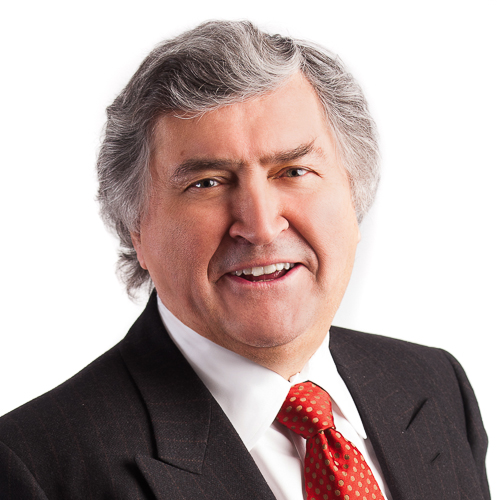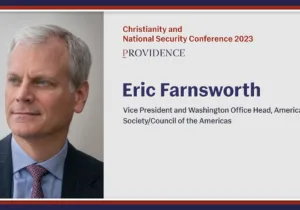Paul Marshall’s lecture at Christianity & National Security 2023.
Paul Marshall discusses the develpment of Muslim empires, European colonialism, and modern radical Islamist groups. The following is a transcript of the event.
I hope you at the back have good eyesight because we will be looking at maps. Anyway, while we’re doing this, my topic will be understanding Muslim-Christian conflict lessons of history. I want to stress that theme of history because, except in South America, people don’t pay much attention to history. Whereas if you’re dealing with particularly the Muslim majority world, people are immersed in it and speak in those particular terms. In the Gulf War or even now with Hamas, there are all sorts of historical illusions being made, which we miss. Indeed, a book I would recommend to you by Ambrose Bierce, written I think over 100 years ago, called The Devil’s Dictionary, a very cynical dictionary and actually funny. Under the heading of War it reads as follows: “War is God’s way of teaching Americans geography.” Oh, something I’m afraid is too true to be entirely funny. But we, the same thing could probably be said of history. Now we having any, Sarah went to get technical help.
Oh, okay, the, um, okay, the, it’s difficult without the maps. So, we have a pattern of a particular conflict, conflict with, um, call it the Muslim majority world. And then what term do we use for the rest? Often it’s sort of Islam versus the West. And I remember the late Bernard Lewis says this is a peculiar conflict. It’s a religion versus a point of the compass. And you know what are we going to say about what the, about what the West is but without the illusion without the illustrations of the map? Let me mention this: According to Islamic tradition, Muhammad born in 570, Muhammad was not only in the, in the Western sense of that word, a religious teacher, but he was also a military leader, led armies and battles and he was a political leader at the time of his, his, his death. They controlled an area in the middle of the… are we getting hold on? Ah, thank you. Going back to this, I started thinking about this talk about a month ago and I thought I want to talk about Islamic things but nobody’s interested in that ’cause it’s China, China, China. Very properly and then Ukraine and dealing with Russia. So, I thought, uh, obviously, uh, with the Hamas attacks, we’re now very interested in that but I did want to put up a couple of maps here to make some of these points.
In dealing with the Middle East here, um, dealing with red, you’re looking at Salafi Jihadi movements, that is, those with a particular ideology of Islamic conquests. There may be other movements in this area who are interested in more local territorial matters but this is one with overarching World historical goals. So, in the Middle East here, in South Asia, if you’re this, different shades, the red it is the worse it is red means there are active attacks going on others are collecting things or there are active groups which can add and let me just finish up. Peter Fan gave us a great introduction to Africa. This is Africa Salafi Jihadi movement over half the territory of Africa. These groups are operating as far down as South Africa and that’s been a major change in the last 20 years. So, this is not just a phenomenon in the Middle East but something which goes much more widely now to the historical things.
At the time of Muhammad’s birth, the controlling power in that area was the Byzantine Empire that is the Eastern Roman Empire. All the colored areas in here are part of that Empire and as you know it survived till 1453. But here is going back to where I was earlier, the, um, very dark purple here, the time of Muhammad’s death, this is probably the area under the control of Muslims that’s the Deep Purple at the sort of not so deep purple here is Islamic expansion by the year 660 that’s 30 years later if we start to include very light colors here this takes us to about 72 which means 100 years after the Islamic prophet’s death they actually at this point they moved higher up to patier but you had, um, um, Muslim Arab armies operating in central France and China and controlling all the area in between this is quite an amazing expansion and one shouldn’t say that sort of well there’s something peculiar about the Arabs in this if the Byzantines could have done it they would I mean that’s what Empires do so you you have this expansion it continues here is a map I’m not sure if you can see the green lines here but of the world within that green line here those are the areas under Muslim control by the year 1100.
Let’s move ahead to 1500 same map you had the reconquista in Spain so the moish armies had been driven out they’d lost that area but expansion across the Sahara and the Sahel right down East Africa control here controlling now most of the Indian subcontinent over into Indonesia the map’s wrong should include the southern Philippines penetration into Central Asia into Russia and then at at this point with the collapse of the Byzantines uh moving into Eastern and and Central Europe so this is an area of this would be the area of Muslim control in the 1500 okay it’s not all one state this they’re fighting within each other but that that’s an area where who’s in charge of this place it’s Muslims so uh and if you’re a Muslim you look at this and say the truth has won out almost from the beginning with you know some the push back in Spain the true religion has shown itself in world history by almost 1,000 years of continuous expansion and not just militarily this was culturally the most powerful it was the richest probably the most cultured in terms of literature philosophy and other things so you you have this confidence in your religion a in in simple terms 1,000 years of almost continual success.
Then it changed, obviously. History doesn’t change on a dime. It happens; you start to lose some battles, then you start to lose more than you win, and the tide begins to change. If I took one symbolic date for the height of Islamic expansion, it would be September 11th, 1683. That’s a fairly arbitrary date, but you will remember it because of the September 11th. At this point, Turkish Ottoman armies were laying siege to Vienna. Okay, again, they’ve done this before and, um, but they got defeated the next day, September the 12th, defeated by Polish and other armies. And it wasn’t just, “Hey, we lost a battle,” but that defeat led to further pushback and being driven out of Austria, then driven out of Hungary. So what you had was, firstly, a pushback by European powers down through Central Europe and pushing back through the Balkans, places such as Hungary, Serbia later on, Bulgaria, Romania. Um, Islamic control is being lost in these particular areas.
A second wave of Europeans or, Muslims would see it with some validity of Christian expansion and imperialism. Firstly, the pushback in Europe but then around the peripheries of this world. Firstly, you have Russia going moving into Central Asia, taking up control of places we now call Kazakhstan, Turkistan, Uzbekistan, and so forth. Then the European powers begin to take over portions of Africa. Italy, France, and Spain begin to take over these areas. Down there, the British move into Nigeria and a lot of these particular areas. Then the British take over India and Pakistan and Bangladesh. The Dutch take over Indonesia. The British take over Malaysia. So what is happening with the phenomena called often now called colonialism is a takeover of these areas around the Muslim world. They were taking over from Muslim rulers; that’s who was dominant in India at the time. So what you’re getting is a wholesale change of now European Christian powers displacing Muslim rulers throughout the world.
This process, after a thousand years of stunning success, and you start to get these things. So here you have a map illustrating all the areas of the world at one time under Muslim rule, not necessarily a majority Muslim population, but that’s who is in charge there. But then you get a shrinkage. This is 1925. Where are Muslims? You know, what are the Muslim-majority places being run by Muslims? Well, as we mentioned with India, Indonesia, places in Asia, places in Africa, well, they’re getting run by Christians. In the Middle East itself, you know, the British are sort of basically ruling Egypt and Yemen and so forth. And the places which were maintaining independence were Central Arabia, soon to become Saudi Arabia, and then Afghanistan. These are about the only, of course, you had Iran, but it’s getting pretty secular. You have Turkey, which is extremely secular, makes France look like it’s Ultramontane Catholicism. So they may be a majority Muslim, but there’s nothing much Islamic about the government. And who is actually running this place? Well, here’s these places. I’m not sure if you can see the Union Jack, Union Jack, Union Jack, Union Jack, France, Spain, others. That’s who’s running the Middle East. So you have those threefold. I’ll call it Christian expansion, firstly to push back out of Europe, expansion into the Islamic periphery, Central Asia, Africa, Asia, and then finally a takeover of the Islamic heartland itself.
So if you’re a Muslim looking at all this, what do you think? Why are people angry? Well, they took us over with the phenomena we call colonialism. By the way, as an aside, I think colonialism is a very misleading word. Because it tries to take European expansion, European imperialism, as if it were distinct from other imperialism. It was distinct in one respect; it was largely done by sea, around that, whereas most empires expand land; you take over your neighbor and then take over. So colonialism sort of wrenches out European imperialism as if it were a distinct phenomenon in the world other than by the fact it was maritime.
We have the Ottoman Empire, we have the Russian Empire. We don’t call it that, but Russia expanded for several centuries about 50 square miles a day and, um, all the way to the Pacific. So there’s lots of imperialism going on there that needs to be remembered. But in terms of if you’re a Muslim looking at this, what happens now is saying, well, you have taken over our countries, you have dominated them, and a response could be, let’s go back to those earlier maps. It says, well, you did it to us first. You’ll probably know you did it first is usually not a very effective argument in almost any setting, but still, the picture I’m trying to give you is that pattern of Muslim Islamic success followed by crippling failure at the hand of what do we call it, Europe, the West, Christendom, or whatever. And this has caused many things because it’s more recent. In the Islamic World, a tremendous resentment. We could use the, uh, go back one if you just take the Middle East, saying, well, that’s where we were 100 years ago, and you did it. So this has produced a lot of anger and frustration within Muslims, saying, why, if this is the True Religion, the religion which was dominant, the religion which was successful for a millennium, a thousand years, why have we become crippled and at the bottom of all the league tables in the last 300 years? So there’s a debate, many debates, um, about this. One of them is that we became close-minded, we refused to learn, uh, we lost critical thinking and Science and culture, and so we became primitive. And that’s why we lost to the European powers. Another response is the opposite. We became bad Muslims. When we were truly faithful and followed the way of the prophet and were disciplined and committed, we were successful. But now we have gone chasing after false gods. We have sought to imitate the Western Powers, brought in false and heretical doctrines like nationalism or democracy or various forms of critical thinking. And that’s what’s destroyed us. What do we need to do then? Then we need to get back to an original true pure Islam, you know, Salafists, the original followers of Muhammad in the first Generations. So we need a purified Islam, and then we can go from that to back to this again and then carry on.
Let me give some examples of this. Hizb, which is a radical movement, has been, um, violent in some places, not in others. But this is their map of the caliphate. Looks very familiar to the red one you just looked at. This is ISIS. This is their map. Okay, so these are movements saying we need to get back to Pure Islam, to recapture the Muslim World from these Infidel controllers, and then get back with the program and continue our expansion. And when you’re getting more radical forms of Islam, including, but not restricted to terrorism, this is the sort of agenda and underlying picture you see. And in terms of the historical examples, it’s not a stupid view of History. If you read through, say, Osama bin Laden, he describes these particular things. So where does that leave us? Let me, we’re dealing with ISIS, as you can see from the earlier maps, very widespread. Al-Qaeda and the original map of Africa. Al-Qaeda, ISIS, and other groups extremely active in the Indian subcontinent and also in the Middle East. Some comment, and then I’ll open to questions. Where does Hamas fit in this? Well, it is a group like Al-Qaeda and ISIS, not only in its tactic but in its worldview. It is not a Palestinian nationalist movement. It believes nationalism is a heresy; people should not be organized according to particular Nations but according to Islam. It is not a movement for democracy; democracy is a heresy. It’s quite explicit in its charters. It is one of these types of movements and commits itself not to negotiate but to wage war. And when you see people saying, you know, Hamas is fighting against Colonialism, settlers, or whatever, Hamas may use this for public consumption in the west, but they’re quite explicit in Arabic writings that this is an Islamic agenda, to restore, to restore control again, sort of west of the Jordan River but to continue that expansion and to get rid of groups which are not with the program, such as the PLO. It killed the PLO representatives in, um, in Gaza. So as we look at increasing tensions in the Middle East but throughout Africa, the Indian subcontinent, even in the southern Philippines. It was little reported, but ISIS-affiliated groups took over a town of 250,000 people in the southern Philippines, this now about four years ago, and held it for two months. So this is going on throughout the world. So, be aware of this extent in terms of understanding much of the Muslim world to get some sense of this history of success and failure but also being victimized, which they were, being victimized. So, we need to acknowledge that. So there’s that history behind us and that continual conflict. The question before us is, how do we end this? And the first step in that is to realize what this cycle has been and what this history is has been and not keep projecting some more recent secular mindsets on a conflict which has strong religious roots. Let’s open it up to questions. Thank you.






